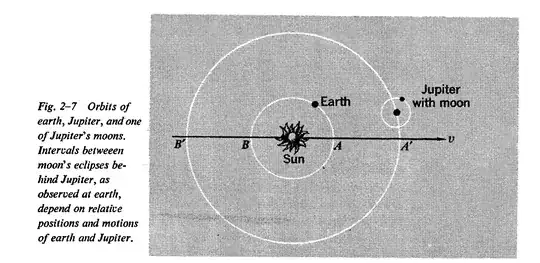In A.P. French's Special Relativity, the author said,
Jupiter has a period of $12$ terrestrial years, and so in half a terrestrial year, while the earth moves from $A$ to $B$ (Fig. $2$-$7$), Jupiter does not travel very far in its orbit. Thus by observing the apparent times of eclipses with the earth successively at $A$ and at $B$, we can infer the time taken for light to travel a distance equal to the diameter of the earth's orbit. This was Roemer's discovery, in fact. But if this time is measured when Jupiter is first at $A'$, and then, $6$ years or so later, at $B'$, we can hope to discover whether the whole solar system is moving through the luminiferous ether with some speed $v$.
For, if the diameter of the earth's orbit is $l$, we would expect to have $$t_{1}=\frac{l}{c+v}~~~~~~~~~~~~~~~~t_{2}=\frac{l}{c-v}$$ and hence a time difference $\Delta t$ given by $$\Delta t=t_2-t_1\approx\frac{2lv}{c^2}=\frac{2v}{c}t_0$$ where $t_o = 16$ min approximately.
The text is talking about measuring the duration of the eclipses when Jupiter is first at $A'$ ($\Delta t_{1}$, say), and then at $B'$ ($\Delta t_{2}$). But On the other hand $t_1$ is obviously the time taken by light to travel from the sun to Earth when Jupiter is at $A'$, and $t_2$ is the time taken by light to travel from the sun to Earth when Jupiter is at $B'$.
After seeing the equations, the text seems rather ambiguous: The text is talking about "measuring" times, yet there is no way we can measure $t_1$ and $t_2$.
How is $t_{1}$ (or $t_2$) actually related to $\Delta t_1$ ($\Delta t_2$)? Am I misinterpreting $t_1$ and $t_2$?
Or, simply put, shouldn't $t_1$ be $AA'/({c-v})$ and $t_2$ be $BB'/({c+v})$?
